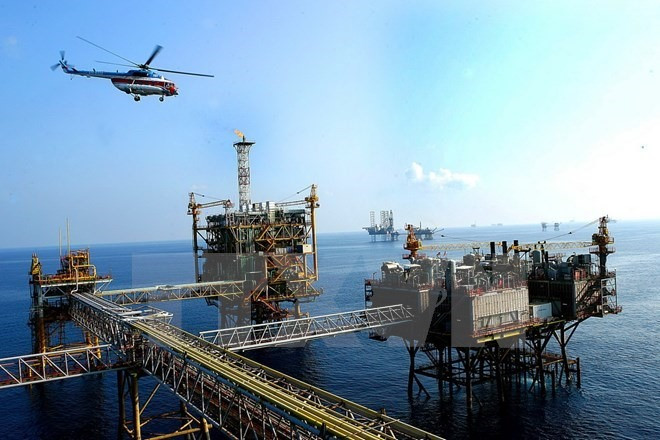 An oil rig of PetroVietnam. Major oilfields have been exploited for a long time and are in the final stages with production declining by 15-30 percent per year. (Photo: VNA)
An oil rig of PetroVietnam. Major oilfields have been exploited for a long time and are in the final stages with production declining by 15-30 percent per year. (Photo: VNA)Hanoi (VNS/VNA) - The rapidexhaustion of its main oil discoveries is putting the Vietnam National Oil andGas Group, better known as PetroVietnam, under great pressure to reach its oilexploration and production targets for 2018.
PetroVietnam produced 15.52 million tonnesof oil in 2017, surpassing its set target by 1.3 million tonnes. However, thecountry’s sole oil exporter has reduced its 2018 production target by onemillion tonnes, due to concerns over the depletion of natural oil resources.
Its general director, Nguyen Vu Truong Son,acknowledged that most of the oilfields have been exploited for many years andare in their final stages, with production declining by 15-30 percent per year.
The Bach Ho (White Tiger) field, thecountry’s largest and longest-producing oilfield, contributing about 60 percentof the nation’s total oil production for PetroVietnam, is in a state ofdepletion and can only be explored in 4-5 years.
In addition, the rapid flooding, at over 60percent, in many fields due to intensive exploitation, such as Hai Su Trang (WhiteSea Lion), Te Giac Trang (White Rhino), Su Tu Vang (Yellow Lion) and Rang Dong (Dawn),is posing a challenge that may reduce oil production in the coming years, Sonsaid.
According to Vietsovpetro’s generaldirector, Tu Thanh Nghia, the largest problem facing the company is the sharpdecline in output at its major oilfields, such as at Bach Ho and Rong (Dragon),while new discoveries, such as Gau Trang (White Bear) and Tho Trang (WhiteRabbit), are small fields with low reserves.
Therefore, the production plan of fourmillion tonnes of oil per year remains a large challenge for theRussian-Vietnamese oil and gas exploration joint venture, Nghia said atPetroVietnam’s conference to set 2018 tasks.
Under-funded exploration
The year 2017 proved to be the mostdifficult year for PetroVietnam’s exploration activities, when oil reservesincreased by only four million tonnes, which was much lower compared to thestrategic target of 28-42 million tonnes per year.
In previous years, PetroVietnam ofteninvested over 2 billion USD to drill 30-40 oil wells and replenish its oilreserves by 35-40 million tonnes per year, but from 2015 onwards, investmentsfrom the group and its foreign partners have decreased by five times.
“It all started with exploration,” said NguyenQuynh Lam, PetroVietnam’s deputy general director, who is in charge ofexploration activity.
Lam said weak exploration would lead to oilshortages for other activities, including petrochemical refining, electricityand fertiliser production. He expected the Government would soon approve thegroup’s financial regulations, allowing it to extract money for the explorationfund.
While awaiting the Government’s approval, Lamsaid PetroVietnam would continue to call for foreign funds for developing someoil and gas fields, and would give up its executive role, in exchange forneeded capital.
Ngo Huu Hai, PetroVietnam Exploration andProduction Corp’s (PVEP) representative, said the company currently lacked atleast 150 million USD for exploration activity in 2018. Its production targetthis year would also decrease by about one million tonnes of oil equivalent.
Hai said the company was implementingmeasures to improve the financial condition and rank projects to restructureits project portfolio, as well as break or relax investment agreements, alongwith reducing costs. - VNA



























